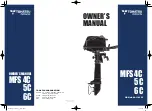
E
1-8
EMU00015
BASIC BOATING RULES
(Rules of the road)
Just as there are rules which apply when
you are driving on streets and high ways,
there are waterway rules which apply when
you are driving your boat. These rules are
used internationally, and are also enforced
by the United States Coast Guard and local
agencies. You should be aware of these
rules, and follow them whenever you
encounter another vessel on the water.
Several sets of rules prevail according to
geographic location, but are all basically the
same as the International Rules of the
Road. The rules presented here in your
Owner’s Manual are condensed, and have
been provided for your convenience only.
Consult your local U.S.
Coast Guard
Auxiliary or Department of Motor Vehicles
for a complete set of rules governing the
waters in which you will be using your boat.
STEERING AND SAILING RULES
AND SOUND SIGNALS
Whenever two vessels on the water meet
one another, one vessel has the right-of-
way; it is called the “stand-on” vessel. The
vessel which does not have the right-of-way
is called the “give-way” or “burdened” ves-
sel. These rules determine which vessel has
the right-of-way, and what each vessel
should do.
Stand-on vessel
The vessel with the right-of-way has the
duty to continue its course and speed,
except to avoid an immediate collision.
When you maintain your direction and
speed, the other vessel will be able to deter-
mine how best to avoid you.
Give-way vessel
The vessel which does not have the right-
of-way has the duty to take positive and
timely action to stay out of the way of the
Stand-On vessel. Normally, you should not
cross in front of the vessel with the right-of-
way. You should slow down or change direc-
tions briefly and pass behind the other ves-
sel. You should always move in such a way
that the operator of the other vessel can see
what you are doing.
“The general prudential rule”
This rule is called Rule 2 in the International
Rules and says,
‘In obeying and construing these rules
due regard shall be had to all dangers
of navigation and collision, and to any
special circumstances, which may ren-
der a departure from the above rules
necessary in order to avoid immediate
danger.’
In other words, follow the standard rules
except when a collision will occur unless
both vessels try to avoid each other. If that
is the case, both vessels become “Give-
Way” vessels.
60V-9-11-1 7/31/02 10:26 AM Page 13
Содержание LZ250B
Страница 1: ...VZ225B Z250B LZ250B VZ250B OWNER S MANUAL U S A Edition LIT 18626 05 27 ...
Страница 4: ......
Страница 6: ......
Страница 14: ...E 1 7 CAUTION LABELS 4 ...
Страница 24: ...E MEMO ...
Страница 50: ...E MEMO ...
Страница 87: ...E 4 10 EMU00366 GREASING Yamaha marine grease Water resistant grease 001599 ...
Страница 115: ...EMU00450 Chapter 6 INDEX INDEX 6 1 E 1 2 3 4 5 6 ...
Страница 124: ......
Страница 125: ......
Страница 126: ...Printed in Japan September 2002 0 9 1 60V 28199 11 Z225HETO Z250DETO LZ250DETO Z250FETO E Printed on recycled paper ...
















































